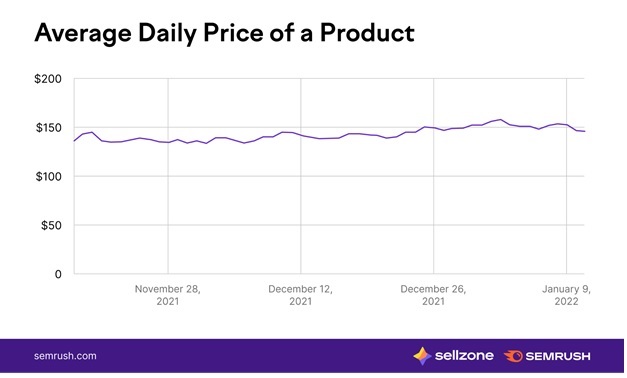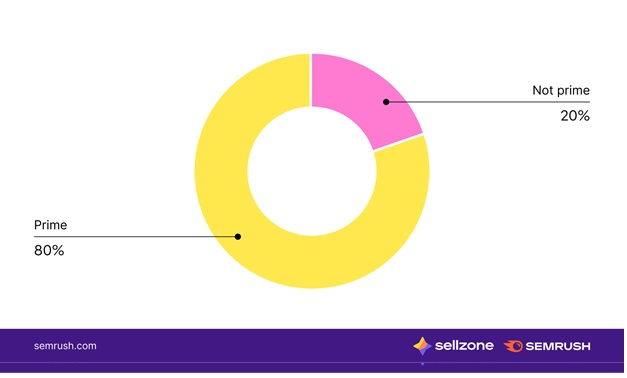If you’re just setting up your ecommerce business or you’re already an established seller who needs to keep up with the market trends, you are probably always asking yourself the same question—is the price right?
And even if it is, how do you catch up with all the discounts and special offers while keeping the margins and profits intact?
Nothing but hard cold data can address these questions. So Semrush came together with its youngest brother Sellzone to gather all their intel and explore Amazon’s pricing patterns.
Amazon is the world’s biggest ecommerce company, so the prices set on the marketplace often serve as the golden standard for the entire ecommerce industry.
That’s why any retailer—large and small—will always have a lesson or two to learn from the sales behavior on Amazon.
Key Amazon pricing patterns you need to know about
This post unwraps some of the key highlights from Semrush’s comprehensive Amazon Pricing Study. But if you want to get more details along with a more granular look at the pricing strategies on Amazon, give the full study a read.
Are higher-priced products a big no?
Intuition will always dictate that lower-priced items will always sell better unless you’ve managed to build an entire brand behind the product.
That’s often true, but our study showed more counter-intuitive findings.
Having analyzed Amazon’s 700 most popular products, we pinpointed that the average product price stands at $142,74. And this is not your typical AliExpress price tag.
The higher average price partially comes from an abundance of tech/digital goods within the most popular products list. But this only means that you shouldn’t be afraid to sell products on the higher end of the pricing spectrum.
In fact, we spotted some exceptionally high-priced items on the most popular product list, with some price tags exceeding tens of thousands of dollars:
The most expensive items across Amazon’s product listings (within 700 most popular Amazon products)
| ASIN | Title | Average Price*** |
| B091G92D34 | Sony VW1025ES 4K HDR Laser Home Theater Video Projector VPL-VW1025ES | $39,998 |
| B08NXGZXTL | Fly YUTING Boss Office Chair Game Cockpit,Gaming Chair Ergonomic Office Chair PC Chair with Massage Lumbar Support, PU Leather High Back with Footrest,C | $39,000 |
| B097BS9QHH | JFF Game Cockpit,Office Chair Gaming Chair Ergonomic Office Chair PC Chair with Massage Lumbar Support, PU Leather High Back with Footrest, White | $38,100 |
| B097BQLMQN | JFF Game Cockpit,Office Chair Gaming Chair Ergonomic Office Chair PC Chair with Massage Lumbar Support, PU Leather High Back with Footrest, Gray | $38,100 |
| B08NXF5KB4 | Fly YUTING Boss Office Chair Game Cockpit, Gaming Chair Ergonomic Office Chair PC Chair with Massage Lumbar Support, PU Leather High Back with Footrest, B | $36,000 |
| B09N1CMTWB | Ecobot Intelligent Automatic Cleaning Robot for Commercial Smart Vacuum Robot Cleaner | $35,999 |
| B07GM3J6SH | Sony 4K HDR Laser Home Theater Video Projector (VPLVW995ES) | $28,673 |
| B091YBSWF1 | TOPESEL 256GB Micro SD Card SDHC Memory Cards UHS-I TF Card Class 10 for Camera/Phone/Nintendo-Switch/Galaxy/Drone/Dash Cam/GOPRO/Tablet/PC/Computer(C10 U1 256GB) | $28,000 |
| B09J49CN7X | MZDJDM Gaming Chair, Zero-Gravity Scorpio Computer Cockpit, Gaming Lounge Chair, Integrated Gaming Table and Chair Space Capsule with Footrest Ergonomic Office Computer Black
advertisement
|
$27,154 |
| B09J48VMM2 | MZDJDM Ergonomic Gaming Chair High Back Computer Chair PU Leather Gaming Cabin with Adjustable Armrest Footrest with Headrest and Massage Lumbar Pillow (Black) | $26,808 |
| B01MYWH09J | Panasonic PT-RS11KU 12 000Lm/ Sxga/ 3-Chip DLP Laser Projector | $24,999 |
| B074Z53X99 | Sony VPLVW885ES 4K HDR Laser Home Theater Video Projector | $24,998 |
| B07YP9CPF5 | LG SIGNATURE OLED88Z9PUA Alexa Built-in Z9 88″ 8K Ultra HD Smart OLED TV (2019) | $24,330 |
| B09KH3292D | WLGQ Gaming Chair, Zero-Gravity Scorpio Computer Cockpit, Gaming Lounge Chair, Integrated Gaming Table and Chair Space Capsule with Footrest Ergonomic Office Computer Black | $24,154 |
Are there good or bad sales days?
Since our pricing analysis spanned a few months, we could pinpoint some daily and hourly pricing patterns that pointed to repetitive price peaks and lows.
Post-New Year days are typically the most “expensive” ones. So, if you’re running any promotions for your products, consider that January 1 – January 10 prices are the highest.
And encouraging evening sales is even better as the prices tend to peak between 5 pm and 2 am.
What about the pricing during the biggest discount seasons?
You may think that post-holiday pricing looks more appealing to sellers only because January comes after some of the hottest discount seasons, and that’s when prices drop significantly.
But that’s not exactly what we saw.
As a consumer, you may look at our findings and think “all these discount seasons are nothing but a big marketing trick”, but as a seller, you’ll interpret our discoveries differently.
We found that the biggest discount periods—namely, Black Friday and Christmas—don’t feature notable price decreases.
During the Black Friday period, the average product price only drops by an insignificant 4% margin. During Christmas, the prices even go up by that very same 4%.
You can blame it on the supply-demand market structure—since the demand for products spikes, the higher prices follow—or on the smart sellers that pump up the prices just before the discounts begin, but numbers don’t lie.
In fact, we saw a lot of cases when the product’s original price was artificially increased just to showcase a more impressive discount, while our data showed that the product never came with the quoted price during the entire analyzed period.
So, if you’re afraid of losing profit during the hottest sales seasons, it doesn’t have to be the case because other sellers manage to capitalize on the demand spike rather than lose their margins.
What can trigger your sales?
On top of pricing, a few other drivers help the customer make the final purchasing decision and choose in your favor.
We looked at the most popular Amazon deals and labels that indirectly point to the additional buying triggers.
If you think it’s the larger discount percentage or the Best-Seller label that seals the deal, you’ll be wrong.
The overwhelming majority of the most popular and in-demand products feature just the Prime label.

This implies that what consumers value the most is fast and free delivery.
And it’s not just true for Amazon shoppers. The marketplace just sets the bar for customers’ expectations, which means that whatever ecommerce platform you’re on, you must meet these new expectations.
About Semrush and Sellzone
Semrush is a comprehensive platform for all things online visibility and content management. It is power-packed with 50+ tools that cover your entire digital presence: SEO, online advertising, social media, market analysis, competitive research, content marketing, and even agency management.
Sellzone, brought to you by the Semrush team, is a toolkit for managing your Amazon business—from product research, Amazon SEO, and split testing to listing protection, growth hacking, and Amazon PPC automation.
All the Amazon pricing data came from Sellzone while Semrush’s data teams have put their brains to create a data analysis model that helped to process and analyze all this intel to bring the study to life.
Over to you
As you can see, ecommerce pricing strategies aren’t always as straightforward as you’d expect. Previously, we’d say that only experience and a journey of trial and error can guide you towards higher profits and wider margins.
But with more big data on our hands, we can actually use it to track certain pricing patterns, understand other sellers’ hits and misses, and learn from their tactics and the general market’s trends.
This post only revealed the key highlights of our discoveries. If you are a seller and occupy a certain market niche, make sure to dive into the full Amazon Pricing Study to unwrap category- and product-specific pricing patterns we haven’t brought up here.
Favorite